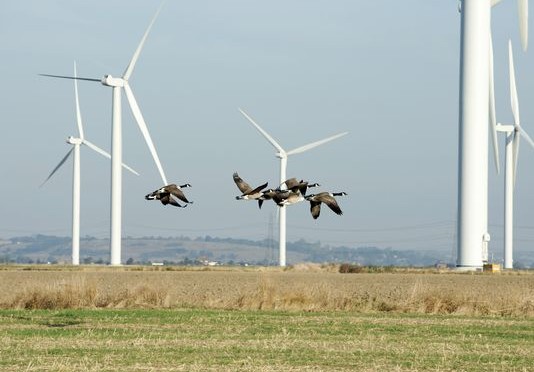Achieving a sustainable future depends on significantly expanding our nation’s clean energy supply while also protecting and conserving wildlife. The Wind Wildlife Research Fund is a unique, industry-led initiative that pools resources to advance independent, peer-reviewed research and deliver solutions to wind-wildlife challenges.
An area of interest for industry and conservation stakeholders is understanding the opportunities and constraints of curtailing wind turbines to protect bats. Curtailment involves increasing the “cut-in” speed for a wind turbine – that is, the wind speed at which it begins to generate power – above the wind speed established by the turbine manufacturer. Bats become less active as wind speeds increase but may still be active at wind speeds low enough to generate power.
By increasing turbine cut-in speeds, operators can reduce bat fatalities, but this benefit comes with corresponding financial and climate costs because curtailment reduces the amount of clean power generated. It’s also important to recognize that curtailment isn’t a viable option for all wind farms due to technological, contractual, or operational constraints. For example, older turbines weren’t designed with curtailment in mind, so changing the cut-in speed can be technologically complex, if not impossible – although as wind farms are repowered with modern turbines, this challenge will be lessened. (Click here to learn more about curtailment and how it is used).
Where curtailment is possible, it presents a critical clean energy / conservation conundrum: what is the optimal level of curtailment at a given wind farm or for specific turbines to minimize both bat fatalities and power losses? A Fund-supported study recently published by PLOS ONE, “Assessing the effectiveness and measurement of curtailment strategies for reducing bat fatalities at terrestrial wind farms,” explored this question.
This study examines two sets of questions:
- First, from an ecological standpoint, can it be confirmed that curtailment helps reduce bat fatalities? And if so, are larger magnitude curtailments – meaning, greater increases in cut-in speeds – better?
- Second, how much information is needed to successfully evaluate the first set of questions? And, how effective are studies of curtailment at individual turbines in measuring reductions in fatalities?
While the second set of questions pertains to the methodology of curtailment studies and is important for developing approaches based on sound science, the first set of questions gets at the heart of how best to balance the climate value of clean energy production with species-specific conservation goals.
Drawing on data from the American Wind Wildlife Information Center (AWWIC) and public sources, the researchers performed a meta-analysis that leveraged information from 36 separate curtailment studies for a combined total of 988 turbines and 2,618 survey nights. Their overarching finding was that curtailment is very effective at reducing bat fatalities – overall, a 63% decrease was achieved across all the studies analyzed. However, the degree to which curtailment reduces bat fatalities at a specific wind energy facility can vary widely for a range of reasons, some of which are not yet well-understood.
Determining the optimal magnitude of curtailment was more challenging. While the researchers had access to a relatively large pool of information, variations in how the 36 studies were conducted meant that it wasn’t possible to directly compare different cut-in speeds. Instead, the magnitude of change in cut-in speed was used. As such, studies that tested the effectiveness (in terms of reduced bat fatalities) of increasing cut-in speeds by 1 m/s were compared to studies that tested the effectiveness of increasing cut-in speeds by 2 m/s or 3 m/s.
While it appears that higher cut-in speeds reduced fatalities, the researchers were not able to determine the degree to which this was the case, noting that “While the overall effect of curtailment on bat fatalities was clear, the relative effect of incrementally larger increases in curtailment cut-in speed was not.” The authors ultimately concluded that “…additional well-designed curtailment studies are needed to determine precisely whether higher cut-in speeds can further reduce bat fatalities.”
These findings and other results from the Wind Wildlife Research Fund are critical to balancing the twin imperatives of reaching our renewable energy goals to mitigate climate change while protecting species. Since its inception in 2019, the Fund has supported several research projects on key topics like this, delivering credible, science-based solutions to wind-wildlife issues. The Fund is managed by the American Wind Wildlife Institute (AWWI), and all Fund projects align with AWWI’s National Wind Wildlife Research Plan guidelines.
Companies that invest in the Fund collaborate to identify research priorities, and benefit from priority access to the results. To learn more, please contact AWWI Executive Director Abby Arnold at 202-448-8775 or [email protected].
Author:
Stu WebsterSenior Director, Wildlife & Federal Lands[email protected]


